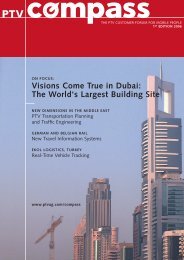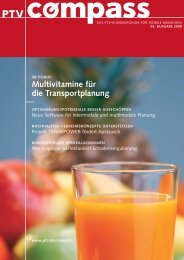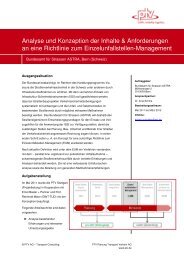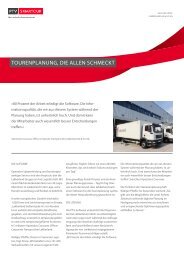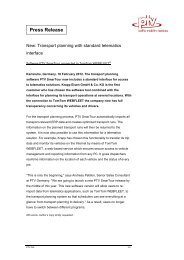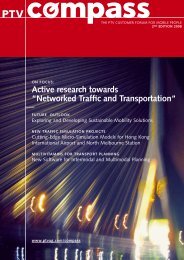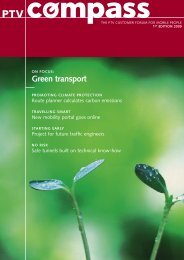Pedestrians' big debut in traffic simulation - PTV America
Pedestrians' big debut in traffic simulation - PTV America
Pedestrians' big debut in traffic simulation - PTV America
Create successful ePaper yourself
Turn your PDF publications into a flip-book with our unique Google optimized e-Paper software.
Multi-modal <strong>traffic</strong> <strong>simulation</strong><br />
with realistic <strong>in</strong>teraction<br />
numbers. Sooner or later, most <strong>traffic</strong> eng<strong>in</strong>eers will<br />
have to tell the city council what their plans are. A film<br />
can communicate their vision much more impressively<br />
than a bunch of numbers. Visualiz<strong>in</strong>g <strong>traffic</strong> plann<strong>in</strong>g<br />
results for laypeople and decision makers is a major<br />
feature of our software,“ said Vortisch.<br />
If, for example, a city is plann<strong>in</strong>g to <strong>in</strong>stall a <strong>traffic</strong>-<br />
calm<strong>in</strong>g measure to make a square more pedestrianfriendly,<br />
the program allows users to determ<strong>in</strong>e the<br />
impact on <strong>traffic</strong> and <strong>in</strong>itiate the required construction.<br />
In this context, it is important to not only provide<br />
urban planners with the appropriate <strong>in</strong>formation, but<br />
also to make such <strong>in</strong>formation understandable for<br />
members of the community <strong>in</strong> order to <strong>in</strong>volve them<br />
<strong>in</strong> the further development of their life space.<br />
How it all began –<br />
<strong>in</strong>sights <strong>in</strong>to the development<br />
When <strong>PTV</strong> decided to <strong>in</strong>tegrate pedestrian <strong>simulation</strong><br />
<strong>in</strong> its product family, it began look<strong>in</strong>g for a partner <strong>in</strong><br />
academia. Peter Vortisch expla<strong>in</strong>s why the company<br />
contacted Dirk Helb<strong>in</strong>g from the Swiss Federal Institute<br />
of Technology <strong>in</strong> Zurich. “Helb<strong>in</strong>g has been work<strong>in</strong>g<br />
on the social force model for pedestrian dynamics for<br />
years. When we looked for a research partner, we<br />
wanted a model that would complement our own<br />
methodical approach and be as microscopic as possible.<br />
The social force model is ideal because it cont<strong>in</strong>uously<br />
looks at the space and thus allows you to represent<br />
reality <strong>in</strong> a realistic fashion.“<br />
The <strong>PTV</strong> experts <strong>in</strong>volved potential users throughout the<br />
entire development process. The software was developed<br />
<strong>in</strong> close consultation with users <strong>in</strong> the field so that<br />
it would conta<strong>in</strong> precisely the components they needed.<br />
VISSIM has always modelled pedestrians, but there<br />
was only a greatly simplified behavioural model for<br />
them. It was used, for example, to simulate the obstacles<br />
for motorists turn<strong>in</strong>g right. However, it was not<br />
possible to model pedestrian behaviour <strong>in</strong> correct<br />
quantities.<br />
“In order to embed pedestrians <strong>in</strong> VISSIM, we had to<br />
not only add another behavioural model, but also enhance<br />
the <strong>simulation</strong> mechanics and handl<strong>in</strong>g,“ said<br />
Vortisch. “The decisive factor is that pedestrians move<br />
on a plane and not l<strong>in</strong>early like vehicles. Vehicles are<br />
bound by lanes. Pedestrians move around freely on a<br />
plane, and can walk to the side or back. What‘s more,<br />
they can stop and speed up with hardly any loss of<br />
time. That means we now have to look at a new element<br />
which is orientated towards planes and not lanes.<br />
We have therefore significantly expanded the user <strong>in</strong>terface<br />
to model the pedestrian <strong>in</strong>frastructure as well.“<br />
The driv<strong>in</strong>g force – the social force model<br />
Dirk Helb<strong>in</strong>g and Peter Molnar developed the social<br />
force model <strong>in</strong> 1995. Pedestrians‘ movements are modelled<br />
by different forces based on Newtonian concepts.<br />
This <strong>in</strong>cludes the driv<strong>in</strong>g force, which causes<br />
pedestrians to generally move towards a certa<strong>in</strong> target,<br />
i.e., walk towards their dest<strong>in</strong>ation at a certa<strong>in</strong> pace.<br />
However, they are <strong>in</strong>fluenced by different elements.<br />
First, people keep a sort of “safety distance“ from other<br />
pedestrians and from obstacles or build<strong>in</strong>gs. Second, different<br />
attractions – such as shop w<strong>in</strong>dows, for example<br />
– distract them so that they change their path. There<br />
are thus psychological (social force) and physical factors<br />
that are taken <strong>in</strong>to account dur<strong>in</strong>g modell<strong>in</strong>g.<br />
How the new pedestrian<br />
<strong>simulation</strong> <strong>in</strong> VISSIM<br />
came about<br />
TRAFFIC<br />
COMPASS INTERNATIONAL 01/2008 07



